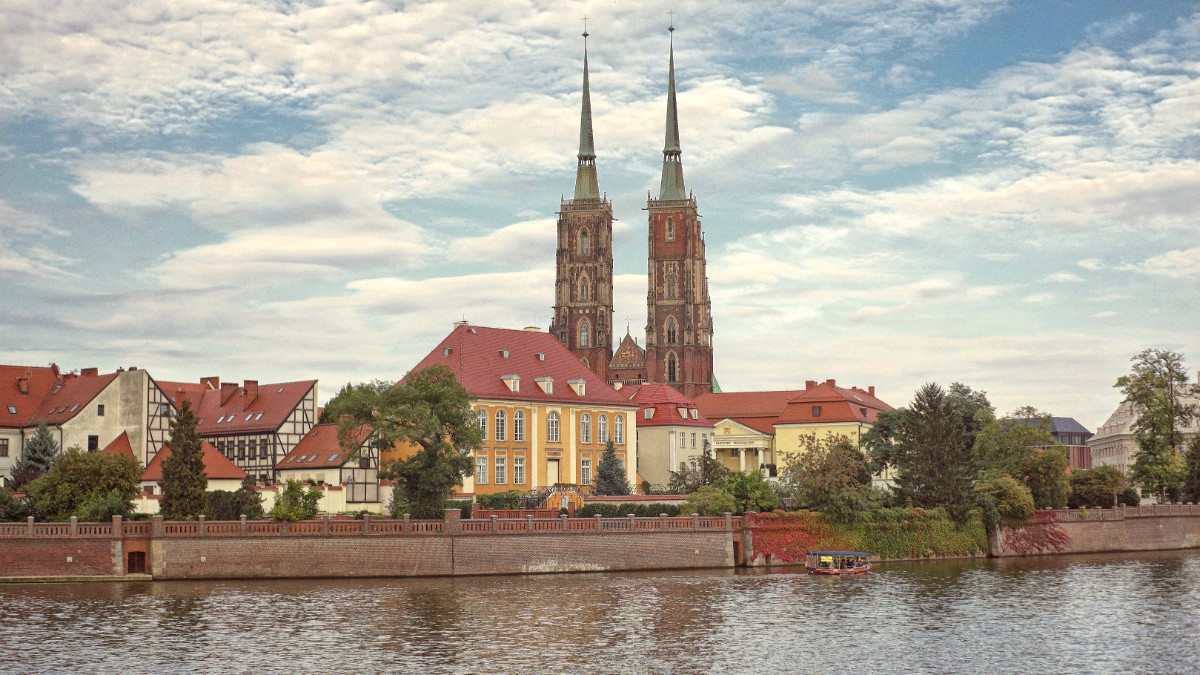
Silesia, Poland
Polish cuisine is known for its hearty, comforting, and often rich character. It mirrors a history of relying on locally available produce and meats, especially during colder months. The cuisine has absorbed influences from its neighbors, including German, Czech, and Slavic traditions.
Silesian cuisine, unique to the Wrocław region, possesses its own distinct identity, with distinguished influences from German and Czech culinary traditions. This regional variation adds another layer to the city's food offerings.
Potatoes, various cabbages (fresh and sauerkraut), beetroot, mushrooms, pork, chicken, buckwheat, barley. Dairy products like sour cream and quark cheese are frequently used.
Dishes often present a savory profile. A sour note from fermented cabbage or cucumbers frequently appears. Dill and marjoram are popular herbs, giving depth to stews and soups.
Characteristic dishes include Silesian dumplings ("kluski śląskie") and roulade ("rolada śląska"), a beef roll with bacon, pickle, and onion, usually served with red cabbage. These reflect local produce and historical influences.
Polish dumplings with various fillings: Ruskie (potato and quark cheese), z mięsem (meat), z kapustą i grzybami (cabbage and mushrooms), or z owocami (fruit, seasonal). Find them at traditional Polish restaurants or "bary mleczne."
A culinary icon, widely found throughout the city.
Known as "Hunter's stew," featuring sauerkraut and fresh cabbage, various meats, mushrooms, and spices. Simmers for a long time for melded flavors. Find it at traditional Polish restaurants.
A hearty and flavorful stew.
Sour rye soup with a fermented rye flour base. Typically includes white sausage, potato, and a hard-boiled egg. Often presented in an edible bread bowl. A staple in traditional Polish restaurants, especially around Easter.
A distinctive and comforting Polish soup.
Polish doughnuts, deep-fried and filled with rose jam, plum jam, or other sweet fillings. A popular treat, especially around Fat Thursday.
Sernik is Polish cheesecake, rich and creamy, made with quark cheese. Makowiec is a traditional poppy seed roll cake, popular during holidays.
Wrocław offers several upscale establishments for refined dining experiences.
These venues balance good food, comfortable settings, and reasonable prices.
Affordable, authentic options for dining on a budget.
Wrocław has a diverse international dining scene. You can find restaurants serving Italian, Indian, Asian (Sushi, Thai, Vietnamese, Chinese), Mediterranean, and American cuisines.
This variety caters to all tastes and presents alternatives to Polish fare. Popular areas for international restaurants include the Old Town and surrounding commercial districts.
Utilize online search engines or dining apps to locate restaurants fitting your international cuisine preferences.
Many modern establishments display their menus online, aiding in your selection.
Growing number of options. Use HappyCow app for dedicated eateries.
Awareness grows in modern restaurants. Carry a translation card for clarity.
Limited dedicated options. Self-catering or specific international restaurants are considerations.
Carry personal snacks if your dietary needs are very strict.
These canteen-style eateries offer subsidized, home-style Polish food at exceptionally low prices. A step back in time and an authentic local experience.
Found across Poland, Wrocław's milk bars offer a distinct cultural encounter.
Many restaurants and cafes line the Odra River, especially around Wyspa Słodowa and Ostrów Tumski. They offer scenic views with your meal.
A distinct Wrocław experience, perfect for pleasant views.
A visit to Hala Targowa (Market Hall) comes highly recommended. This historic indoor market presents fresh produce, meats, cheese, baked goods, and flowers.
Dine at local, independent restaurants and cafes to support the city's unique culinary landscape. Many of these smaller establishments offer authentic dishes and a warm, inviting atmosphere.
Participate in a hands-on class to master the art of making Polish pierogi, a beloved national dish. This activity offers a practical way to learn about local cuisine.
Explore Wrocław's culinary landscape with a guided food tour, sampling traditional dishes and street food. Discover hidden gems and local eateries.
Visit Hala Targowa (Market Hall) to observe local commerce, fresh produce, and traditional snacks. A lively and authentic local experience.
Explore dining spots that emphasize local, seasonal ingredients, connecting you with the region's agricultural heritage. Some restaurants partner directly with local farms.
Look for menus highlighting regional produce.
Wrocław has many charming bakeries and cafes where you can enjoy traditional Polish pastries like pączki (doughnuts) and sernik (cheesecake), alongside freshly brewed coffee.
Discover cozy spots for a delightful morning or afternoon treat.
Clearly state any dietary restrictions to restaurant staff, especially for allergies.
Do not miss experiencing a "bary mleczne" for authentic, budget-friendly Polish home cooking.
Hala Targowa offers a atmosphere and delicious local snacks and produce.
Exploring Wrocław's food scene goes beyond tasting. It includes understanding the city's rich history and cultural influences embedded in its dishes.